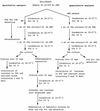Prevalence of pandemic thermostable direct hemolysin-producing Vibrio parahaemolyticus O3:K6 in seafood and the coastal environment in Japan
- PMID: 12839757
- PMCID: PMC165169
- DOI: 10.1128/AEM.69.7.3883-3891.2003
Prevalence of pandemic thermostable direct hemolysin-producing Vibrio parahaemolyticus O3:K6 in seafood and the coastal environment in Japan
Abstract
Although thermostable direct hemolysin (TDH)-producing Vibrio parahaemolyticus has caused many infections in Asian countries, the United States, and other countries, it has been difficult to detect the same pathogen in seafoods and other environmental samples. In this study, we detected and enumerated tdh gene-positive V. parahaemolyticus in Japanese seafoods with a tdh-specific PCR method, a chromogenic agar medium, and a most-probable-number method. The tdh gene was detected in 33 of 329 seafood samples (10.0%). The number of tdh-positive V. parahaemolyticus ranged from <3 to 93/10 g. The incidence of tdh-positive V. parahaemolyticus tended to be high in samples contaminated with relatively high levels of total V. parahaemolyticus. TDH-producing strains of V. parahaemolyticus were isolated from 11 of 33 tdh-positive samples (short-necked clam, hen clam, and rock oyster). TDH-producing strains of V. parahaemolyticus were also isolated from the sediments of rivers near the coast in Japan. Representative strains of the seafood and sediment isolates were examined for the O:K serovar and by the PCR method specific to the pandemic clone and arbitrarily primed PCR and pulsed-field gel electrophoresis techniques. The results indicated that most O3:K6 tdh-positive strains belonged to the pandemic O3:K6 clone and suggested that serovariation took place in the Japanese environment.
Figures





Similar articles
-
Epidemiological evidence of lesser role of thermostable direct hemolysin (TDH)-related hemolysin (TRH) than TDH on Vibrio parahaemolyticus pathogenicity.Foodborne Pathog Dis. 2015 Feb;12(2):131-8. doi: 10.1089/fpd.2014.1810. Foodborne Pathog Dis. 2015. PMID: 25646967
-
Emergence of a unique O3:K6 clone of Vibrio parahaemolyticus in Calcutta, India, and isolation of strains from the same clonal group from Southeast Asian travelers arriving in Japan.J Clin Microbiol. 1997 Dec;35(12):3150-5. doi: 10.1128/jcm.35.12.3150-3155.1997. J Clin Microbiol. 1997. PMID: 9399511 Free PMC article.
-
Major tdh(+)Vibrio parahaemolyticus serotype changes temporally in the Bay of Bengal estuary of Bangladesh.Infect Genet Evol. 2016 Jul;41:153-159. doi: 10.1016/j.meegid.2016.04.003. Epub 2016 Apr 7. Infect Genet Evol. 2016. PMID: 27063395
-
Structure, function and regulation of the thermostable direct hemolysin (TDH) in pandemic Vibrio parahaemolyticus.Microb Pathog. 2018 Oct;123:242-245. doi: 10.1016/j.micpath.2018.07.021. Epub 2018 Jul 19. Microb Pathog. 2018. PMID: 30031890 Review.
-
Pandemic Vibrio parahaemolyticus O3:K6 on the American continent.Front Cell Infect Microbiol. 2014 Jan 2;3:110. doi: 10.3389/fcimb.2013.00110. Front Cell Infect Microbiol. 2014. PMID: 24427744 Free PMC article. Review.
Cited by
-
Sero-Prevalence and Genetic Diversity of Pandemic V. parahaemolyticus Strains Occurring at a Global Scale.Front Microbiol. 2016 Apr 22;7:567. doi: 10.3389/fmicb.2016.00567. eCollection 2016. Front Microbiol. 2016. PMID: 27148244 Free PMC article.
-
Virulence gene- and pandemic group-specific marker profiling of clinical Vibrio parahaemolyticus isolates.J Clin Microbiol. 2007 Apr;45(4):1133-9. doi: 10.1128/JCM.00042-07. Epub 2007 Feb 14. J Clin Microbiol. 2007. PMID: 17301274 Free PMC article.
-
Soft-agar-coated filter method for early detection of viable and thermostable direct hemolysin (TDH)- or TDH-related hemolysin-producing Vibrio parahaemolyticus in seafood.Appl Environ Microbiol. 2006 Jul;72(7):4576-82. doi: 10.1128/AEM.02646-05. Appl Environ Microbiol. 2006. PMID: 16820446 Free PMC article.
-
Genetic relationships of Vibrio parahaemolyticus isolates from clinical, human carrier, and environmental sources in Thailand, determined by multilocus sequence analysis.Appl Environ Microbiol. 2013 Apr;79(7):2358-70. doi: 10.1128/AEM.03067-12. Epub 2013 Feb 1. Appl Environ Microbiol. 2013. PMID: 23377932 Free PMC article.
-
Divergent Influence to a Pathogen Invader by Resident Bacteria with Different Social Interactions.Microb Ecol. 2019 Jan;77(1):76-86. doi: 10.1007/s00248-018-1207-z. Epub 2018 Jun 1. Microb Ecol. 2019. PMID: 29858645
References
-
- American Public Health Association. 1970. Recommended procedure for the examination of seawater and shellfish, 4th ed. American Public Health Association, Washington, D.C.
-
- Bag, P. K., S. Nandi, R. K. Bhadra, T. Ramamurthy, S. K. Bhattacharya, M. Nishibuchi, T. Hamabata, S. Yamasaki, Y. Takeda, and G. B. Nair. 1999. Clonal diversity among recently emerged strains of Vibrio parahaemolyticus O3:K6 associated with pandemic spread. J. Clin. Microbiol. 37:2354-2357. - PMC - PubMed
-
- Bhuiyan, N. A., M. Ansaruzzaman, M. Kamruzzaman, K. Alam, N. R. Chouwdhury, M. Nishibuchi, S. M. Faruque, D. A. Sack, Y. Takeda, and G. B. Nair. 2002. Prevalence of the pandemic genotype of Vibrio parahaemolyticus in Dhaka, Bangladesh, and significance of its distribution across different serotypes. J. Clin. Microbiol. 40:284-286. - PMC - PubMed
Publication types
MeSH terms
Substances
LinkOut - more resources
Full Text Sources

